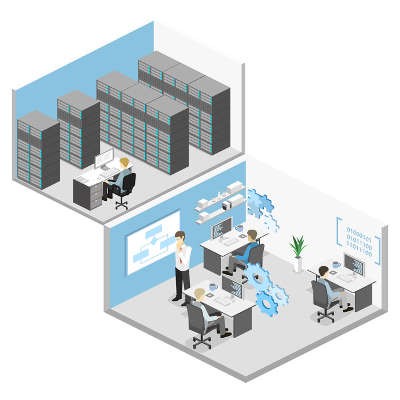NetWorthy Systems Blog
How does your organization manage its mission-critical technology solutions? We know that most small businesses have some sort of trouble with this topic, either due to budget constraints or a lack of personnel. Either way, we know that there is a better way to manage your business’ technology, and it’s all thanks to an approach called managed IT services.
“The good old days” usually refer to times long past, where things were more simple. Businesses a few decades ago didn’t have much complex technology in their office, but nowadays organizations have multiple server units and plenty of workstations--all of which need more maintenance than ever before. What’s the best way for your organization to approach IT maintenance?
Wouldn’t it be great to have a fully-trained and certified staff of IT professionals sitting in the corner of your office, keeping your technology in line? Unfortunately, small businesses often don’t have the budget required to hire an internal IT department filled with security analysts and network technicians. Even if they do, they don’t have the workforce to handle all of the responsibilities of a full IT department. What’s the best way to handle your organization’s IT?
Technology maintenance and management is one of the major pain points of all businesses, but it comes more easily to large organizations that have large budgets. Unfortunately, small organizations are often left out, placing such an important aspect of managing their business on the back burner. How, then, can you take advantage of proactive IT maintenance without breaking your budget?
Consultation is one of those words that you take for granted because you see it everywhere. Think about it, most businesses that provide a professional service offers some semblance of consultation. For the small business owner, can you really afford to pay premium prices to “experts” for them to give you their so-called professional opinion? Besides, what do service providers mean when they use the term “consultation”?
Fundamentally, business is simple: if you take in more revenue than you have expenses, your company is a success. There are just so many elements to manage to ensure that revenues outpace expenses that it becomes difficult to ascertain what you can do to cut costs and see a higher degree of profitability for your efforts.
In the natural course of doing business, an owner/operator will have to face many difficult situations, but none of these situations are as difficult as asking them to determine whether or not to close the doors of the business for good. Many problems could cause a business to fail, but it has to hurt the failing owner a little more when the solution for the problem was not only within his/her reach, it was affordable.
As a business owner, you have plenty to worry about, and your technology doesn’t do you any favors. It’s difficult to oversee the responsibilities of managing technology like workstations, server units, and mobile devices, alongside the ordinary demands of your job. What a lot of organizations don’t realize is that they can improve operations and make their jobs easier by outsourcing the responsibility of technology management to IT professionals.
When was the last time that your organization had an unexpected technology expense blast your IT budget out of the sky? Surprise issues that you don’t plan for could potentially derail your budget for months, or even years, depending on the severity of it. Having a clear idea of what your IT service plan covers is a great way to make sure that you don’t get hit by surprise billing.
You know better than anyone that managing your business isn’t something to be taken lightly. Keeping your technology in proper working order is just the icing on the proverbial cake, making the task of managing your business even more difficult. If you’re using normal break-fix IT services, this might be the case. Alternatively, managed IT services aren’t designed to burden you.
A small business is just as susceptible to the many problems that face large enterprises, and the dangers only multiply with the more technology you implement in the office. The larger your network gets, the more difficult data distribution and storage becomes. The more employees you work with, the more devices that will appear in the office. The more data you work with, the more likely you are to get hacked. These are all very real risks. What are you doing to protect your company from these threats?
Budgeting accurately for your long-term IT needs requires an intimate knowledge about technology and IT trends. Compared to other department budgets that are easy to compile by making a few simple adjustments to the previous year’s numbers, your IT budget must take into account the depreciation of your IT equipment for replacement purposes, as well as the cost of procuring the new, cutting-edge solutions that are shaping your industry. Do you have the technical knowledge to come up with an accurate IT budget? If you don’t, you’ll want to employ the services of an IT consultant.
Every organization has mission-critical systems that they rely on in order to function, and the IT technician is responsible for keeping them running. Modern technology and best practices have given rise to a new way of managing business technology, one that knocks the traditional break-fix IT out of the water.















